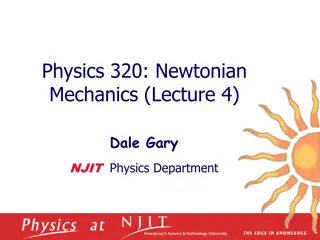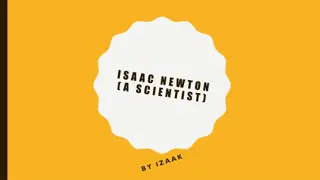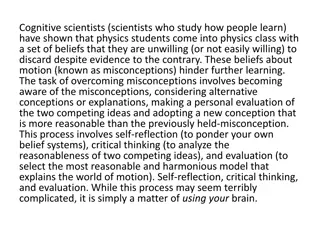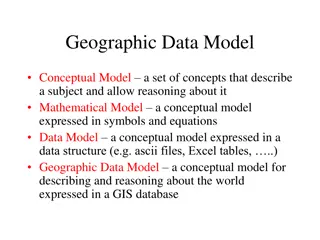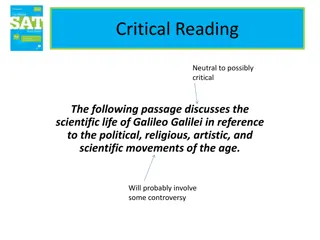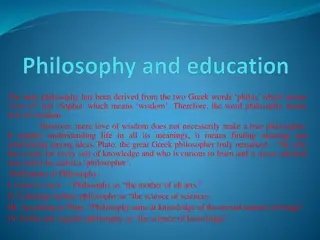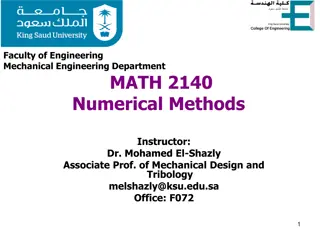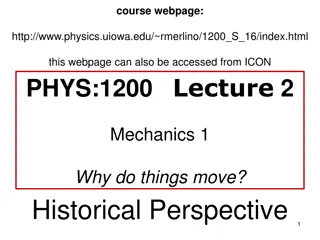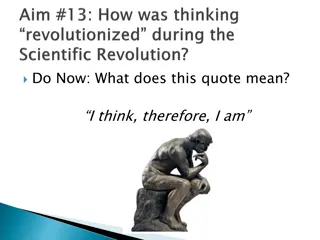Understanding Galileo's Physics and Newton's Philosophy
Explore the intersection of Galileo's terrestrial physics experiments, Galileo's physics discoveries, and Newton's philosophy and physics. From challenging Aristotelian views to introducing concepts like equivalence, inertia, and relativity, delve into the evolution of scientific thought on measurement, methodology, and metaphysics. Discover the importance of data in theory formation, the relationship between measurement and reality, and the impact of methodology on metaphysical assumptions. Learn how testing theories and exploring the nature of reality have shaped modern physics.
Download Presentation

Please find below an Image/Link to download the presentation.
The content on the website is provided AS IS for your information and personal use only. It may not be sold, licensed, or shared on other websites without obtaining consent from the author. Download presentation by click this link. If you encounter any issues during the download, it is possible that the publisher has removed the file from their server.
E N D
Presentation Transcript
Topics for today Galileo s Physics Newton s philosophy & physics How to test a theory Themes: importance of data in forming theories. relation between measurement and reality. relation between methodology and metaphysics.
Galileos terrestrial physics experiments a series of systematic measurements of the motions of terrestrial objects- not a common practice then. Consider also William Gilbert, 1540-1603 To compare Aristotle and Galileo, let's establish some (modern) terminology: Position: with respect to some origin. Displacement: Velocity: Acceleration:
Physics changes its focus Aristotle says there is an absolute and natural position for each kind of object the choice of origin is not arbitrary. an absolute and natural velocity. Zero for earthlike material Motion requires the continuous application of a force. Acceleration is not discussed per se. The motion of an object is explained by its tendency to return to its natural state. For Galileo there is no absolute or natural position. no natural velocity. The velocity of an object will remain constant in the absence of a force. The accelerations of objects are explained by external forces. The complete explication of the law of inertia is due to Descartes. It is not clear that G understood the problem in 3 dimensions. All of his arguments about inertia take place in two, on the surface of the Earth (no vertical motion). (He failed to use the same principle to argue about the tides.)
announcements HW 1 grading to be finished soon HW 2 due Tues. Don t be alarmed about Bohm interpretation etc. You re not expected to know any of that now. We ll get to it. Don t think the part about modern confusion is about your grandparents. It s about us now. On meaningful questions: Do we leave in a spatially 3D universe? Or a spatially 2D universe with different physical laws? Surely that s a meaningful question?
Galileos physics discoveries Discovered what we now call the principle of equivalence. All objects fall at the same rate. (under somewhat idealized conditions) Discovered inertia. Objects continue to move unless acted upon. No preferred motion. (G only understood this for horizontal motion.) Discovered relativity. Moving observers (e.g., on ships) will observe the same laws of physics. Observed that acceleration is the physically interesting aspect of motion. (Looked at balls on inclines.) Discovered superposition. The horizontal and vertical motions of a projectile can be separately analyzed. Argued convincingly that nature must be different on different distance scales. Explained the tides - completely incorrectly! Explanation violated principle that velocity is purely relative.
Galileos Relativity Shut yourself up with some friend in the main cabin below decks on some large ship, and have with you there some flies, butterflies, and other small flying animals. Have a large bowl of water with some fish in it; hang up a bottle that empties drop by drop into a wide vessel beneath it. With the ship standing still, observe carefully how the little animals fly with equal speed to all sides of the cabin. The fish swim indifferently in all directions; the drops fall into the vessel beneath; and, in throwing something to your friend, you need throw it no more strongly in one direction than another, the distances being equal; jumping with your feet together, you pass equal spaces in every direction. When you have observed all these things carefully (though doubtless when the ship is standing still everything must happen in this way), have the ship proceed with any speed you like, so long as the motion is uniform and not fluctuating this way and that. You will discover not the least change in all the effects named, nor could you tell from any of them whether the ship was moving or standing still. In jumping, you will pass on the floor the same spaces as before, nor will you make larger jumps toward the stern than toward the prow even though the ship is moving quite rapidly, despite the fact that during the time that you are in the air the floor under you will be going in a direction opposite to your jump. In throwing something to your companion, you will need no more force to get it to him whether he is in the direction of the bow or the stern, with yourself situated opposite. The droplets will fall as before into the vessel beneath without dropping toward the stern, although while the drops are in the air the ship runs many spans. The fish in their water will swim toward the front of their bowl with no more effort than toward the back, and will go with equal ease to bait placed anywhere around the edges of the bowl. Finally the butterflies and flies will continue their flights indifferently toward every side, nor will it ever happen that they are concentrated toward the stern, as if tired out from keeping up with the course of the ship, from which they will have been separated during long intervals by keeping themselves in the air. And if smoke is made by burning some incense, it will be seen going up in the form of a little cloud, remaining still and moving no more toward one side than the other. The cause of all these correspondences of effects is the fact that the ship's motion is common to all the things contained in it, and to the air also. That is why I said you should be below decks; for if this took place above in the open air, which would not follow the course of the ship, more or less noticeable differences would be seen in some of the effects noted. Dialogue Concerning the Two Chief World Systems, translated by Stillman Drake, University of California Press, 1953, pp. 186 - 187 (Second Day).
Velocity and acceleration in cosmic models If absolute velocity is not meaningful, is the distinction between Kepler s and Tycho s descriptions meaningful? Yes, even though velocity may not be absolutely meaningful, in these mechanics acceleration is. So the question becomes: who is accelerating? (Inward acceleration is needed to keep going around in a circle.)
What accelerations do Keplers laws imply? Equal areas per time acceleration toward Sun Math to follow Now for simplicity, let s assume circular orbits Call radius R, orbital period T
Reasoning in reverse Assume the acceleration is (some constant)/distance2 toward the Sun. Here's what follows (math by Isaac Newton): equal areas about Sun swept per equal times. elliptical orbits with the Sun at one focus with R the long axis Kepler's laws boil down to one two-part law about accelerations- via some math. the acceleration law has two aspects direction magnitude What is special about the Sun that makes things accelerate toward it?
Whats special about Sun? Nothing qualitative. Earth, Jupiter have moons which accelerate toward them, and all sorts of stuff falls to Earth. Are all these accelerations for the same reason? Probably yes, if a similar description holds. So is the acceleration toward the Earth inversely proportional to the square of the distance from the Earth? Yes- comparison of the moon and an apple follows the 1/R2 law if R is taken to be the distance to the center of the Earth. Why should R be taken to the center of the Earth? Assume that each clod of dirt has this attractive power, causing things to accelerate toward it. You have to add up the little acceleration vectors from all the parts of the Earth- some near, some far. How can you add all those little things? The result: the net attraction of anything not actually inside the Earth is exactly the same as it would be if all the Earth's stuff were at the center. Invent integral calculus.
A modest generalization due to Isaac Newton Every object in the universe attracts every other object. The resulting acceleration is inversely proportional to the square of the distance, and proportional to the "mass" of the attracting object. Newton: Applied the same laws to celestial and terrestrial objects. The success of the theory of gravity (see below) is powerful evidence for the validity of this approach. Newton s faith in the approach allowed him to spend much of the period 1665 - 1687 inventing calculus to solve the distributed-mass problem. Ascribed to objects mathematical properties beyond the usual geometrical ones, position and motion E.g. mass. Formulated his three laws of motion:
Three laws of motion Law of inertia. If no forces act, a body s velocity is constant. Contrast the First Law with Aristotle s natural motion! F = ma. A body s acceleration is proportional to the force on it. Newton s slightly more general form did not presume that m is constant. F= time rate of change of momentum, mv. F=d(mv)/dt F12 = -F21 . When object 1 exerts a force on object 2, object 2 exerts an opposite force on object 1. This is new with Newton. The third law implies that total momentum doesn t change- our first conservation law. Note that this law is required by first law if you want invariance under renaming what you call an object. Newton also stated the law of conservation of mass. Conservation laws turn out to have a deep connection to the underlying properties of the universe, which we ll discuss more later.
Three laws revisited You can reformulate Newton's laws as follow: Total momentum is conserved. (law 3) When two objects trade momentum, they do so following some rules which we can discover. We call momentum-trading the exertion of forces . (law 2) There should be some conditions in which "nothing happens"- no momentum is traded. (law 1) Given this information, one can then calculate the accelerations and predict the future motions. We ll see next time how this is related to the concepts of causality and determinism. To make predictions we need to, assign masses measure accelerations know all the force laws specify initial conditions, i.e. initial positions and velocities.
What Newtons three laws do not do They do not tell us how to determine masses of objects. But we can kluge together some test, using momentum conservation They do not tell us how to calculate forces. What are their laws? Even if the first two problems can be solved, they do not tell us how to predict (or even measure) positions and velocities, only how to predict accelerations if we know the positions. What then is the meaning of Newton's 3 laws? If they together form a testable proposition, we need some way of assigning values to F, m, and a. We need some way of measuring "a", say by comparison with the average motion of all the observed stars. We need some way to measure m's- say by introducing some test force which we think is known, and measuring accelerations. Now we need to find F- but the only general rule about F is the third law.
What the 3 laws predict So the general laws now make only one prediction: the sum of the momenta of all the parts of an isolated system (no external forces) doesn't change. Until we know something about the forces, we don't know if isolated systems exist! If we have to include everything to get a closed system, here's the sole prediction of Newton's grand laws of motion: The acceleration of the center-of-mass of everything is zero. That's good, but now let's remember what we were measuring motion with respect to.
The prediction Our reference frame was the average motion of everything. So now we have the sole prediction of Newton's three laws: The acceleration of the center-of-mass of everything is zero relative to the center-of-mass of everything! ( Some version of this argument was originally due to Kant.) Why do we then consider Newton's laws to be a major achievement? How can we invest Newton's laws with some meaning, i.e. make them more than a tautology?
Toward a testable version of Newtons laws Specify all the force laws. (Not yet done!) Make some implicit assumptions about the forces A. predictable in terms of other observables B. reasonably local C. reasonably simple e.g. If the eraser jumped off the table, and I said "Alpha Centauri exerts a force on erasers at 3 pm CST each Thursday immediately preceding the first SuperBowl after a disputed election in Florida at 3pm each Thursday DST immediately following a 16 inning StL Cardinals win , following a 4-3 Cardinal loss you might suspect that I could make up a force law to fit any data.
Philosophy and Fuzz It might sound as if our rules for constraining the force laws are hopelessly fuzzy, that we'll always be able to invent forces to make Newton's laws work. That can't be quite true, however, because these days we agree that Newton's laws are NOT TRUE. In particular it is not true that F=ma evenfor objects that aren t shedding or picking up other mass. How would we have reached that conclusion that if the laws connection to reality was completely flexible? Note the philosophical lesson: "survival of the fittest" is often criticized as a tautological principle. It is- but becomes fleshed-out and meaningful in the same way Newton's laws of motion do, by the added imprecise assumption that "fitness" is comprehensible, predictable, etc. Even the most precise, mathematical, laws acquire their meaning through less precise connections with the observable world.
Gravity Newton described one general force law. He made the huge generalization from knowing that the Earth pulls on all sorts of nearby things and on the moon, the Sun pulls on the planets, and Jupiter pulls on its moons, to this: Everything pulls on everything else. r GMm The law of gravitational attraction: F = 2 r combining this general law with the math to add up the effects of all the little bits of stuff in a ball (the Earth), he concluded that the Earth acts as if its mass were all at the center: justifies comparing accelerations of moon and apple. Those M s must be the same as the inertial M s if Galileo s observation of equal accelerations ( equivalence ) is right. {3d law + equivalence} implies inertial M is the source of gravity. It is often alleged that a scientific theory should not make claims about phenomena other than those specifically shown to obey it. If that were the grading criterion, what grade would Newton have received on the law of universal gravitation?
Features of a good theory An economical description of phenomena All three of Kepler slaws can be derived from Newton s gravitational law. including the toward-the-Sun part and the 1/r2 part, logically independent. Kepler had tried and failed to do the same thing (he tried a 1/r force). Furthermore Newton's gravity described erasers, apples, etc. by the same law that described Jupiter, Venus, etc. ! The ability to predict new phenomena or explain (in Galileo s sense) previously non-understood ones. Newton s law of gravity explains the multiple centers of motion. There is nothing special about the Sun, except that it is very massive. Jupiter and its moons interact in the same way as the Sun and the planets. It predicts small deviations from Kepler s laws. (from nearby planets) It explains the tides. Astronomy has fewer distractions than terrestrial phenomena. How do we know which are the relevant phenomena and which are distractions?
What happens when predictions fail? Newton's gravity forms a complete theory for astronomy if you add the auxiliary assumption that no other forces are significant for that scale of phenomena. It predicts that Kepler's laws should be about right assuming only that the Sun has a much bigger mass than the planets, with small deviations due to the mutual attractions of the planets. So far so good. But The motions of Jupiter s moons lag or lead the predictions of Newton's theory by about eight minutes. This is a big effect. The motions of Uranus didn't quite fit the theory. the motions of Mercury didn't quite fit the theory. Does this mean that Newton is wrong? (remember what happened to previous theories that made small errors)
Patching holes Jupiter's moons: Interpreted by R mer in 1672 as due to a finite speed of light, and the variable distance from Earth to Jupiter. The theory we're testing is unmodified, but another assumption about how things are measured turns out to be wrong. ok, that was actually before Newton, as it happened The orbit of Uranus: An ad-hoc patch was proposed- another planet, whose orbit could be determined from the deviations of its observed neighbor. So the discrepancy turned into a prediction. The discovery of Neptune in 1845 was the crowning triumph of Newton's theory. Snide aside: It was claimed by a prominent literary scholar here that Neptune was "socially constructed" because theory preceded observation. A history grad student asked how it happened that the social construction was so complete as to place bright spots where Neptune was supposed to be in photographs taken before anyone thought to look there for a planet. The orbit of Mercury: An ad-hoc patch was proposed- another planet, whose orbit could be determined from the deviations of its observed neighbor. The other planet wasn't found. What gives? Stay tuned.


![Read⚡ebook✔[PDF] Io After Galileo: A New View of Jupiter's Volcanic Moon (Sprin](/thumb/21612/read-ebook-pdf-io-after-galileo-a-new-view-of-jupiter-s-volcanic-moon-sprin.jpg)




